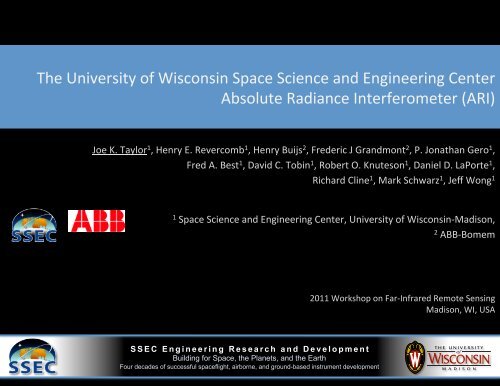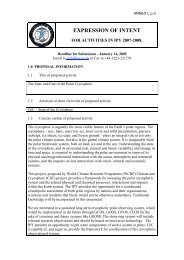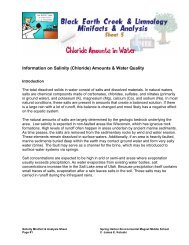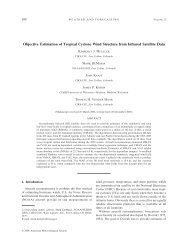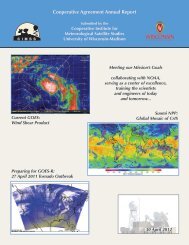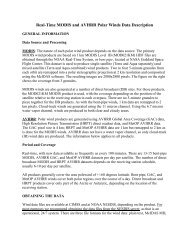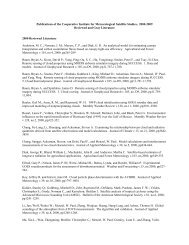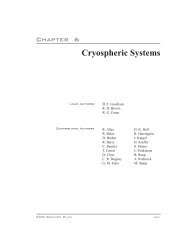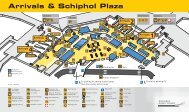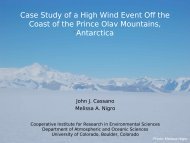The University of Wisconsin Absolute Radiance Interferometer - SSEC
The University of Wisconsin Absolute Radiance Interferometer - SSEC
The University of Wisconsin Absolute Radiance Interferometer - SSEC
You also want an ePaper? Increase the reach of your titles
YUMPU automatically turns print PDFs into web optimized ePapers that Google loves.
<strong>The</strong> <strong>University</strong> <strong>of</strong> <strong>Wisconsin</strong> Space Science and Engineering Center <br />
<strong>Absolute</strong> <strong>Radiance</strong> <strong>Interferometer</strong> (ARI) <br />
Joe K. Taylor 1 , Henry E. Revercomb 1 , Henry Buijs 2 , Frederic J Grandmont 2 , P. Jonathan Gero 1 , <br />
Fred A. Best 1 , David C. Tobin 1 , Robert O. Knuteson 1 , Daniel D. LaPorte 1 , <br />
Richard Cline 1 , Mark Schwarz 1 , Jeff Wong 1 <br />
1<br />
Space Science and Engineering Center, <strong>University</strong> <strong>of</strong> <strong>Wisconsin</strong>-‐Madison, <br />
2<br />
ABB-‐Bomem <br />
2011 Workshop on Far-‐Infrared Remote Sensing<br />
Madison, WI, USA <br />
<strong>SSEC</strong> Engineering Research and Development<br />
Building for Space, the Planets, and the Earth<br />
Four decades <strong>of</strong> successful spaceflight, airborne, and ground-based instrument development
Summary <br />
• <strong>The</strong> <strong>University</strong> <strong>of</strong> <strong>Wisconsin</strong>-‐Madison Space Science and Engineering Center (UW-‐<strong>SSEC</strong>) <br />
and Harvard <strong>University</strong> (HU) submiWed a successful joint proposal enXtled “A New Class <br />
<strong>of</strong> Advanced Accuracy Satellite InstrumentaXon (AASI) for the CLARREO Mission” to the <br />
NASA Instrument Incubator Program (IIP). <strong>The</strong> UW-‐<strong>SSEC</strong> / HU team has a long history <br />
with the scienXfic and measurement concepts that have formed the foundaXon for <br />
climate benchmark measurements from space <br />
• <strong>The</strong> objecXve <strong>of</strong> this effort is to advance the technological development <strong>of</strong> advanced <br />
accuracy instrumentaXon for the measurement <strong>of</strong> absolute spectrally resolved infrared <br />
radiances (3.3 – 50 μm) with high accuracy (< 0.1 K, k = 3, brightness temperature at <br />
scene temperature) for climate benchmark measurements from space <br />
• <strong>The</strong> UW-‐<strong>SSEC</strong>, is building a demonstraXon test bed which includes an FTS instrument <br />
and calibraXon and validaXon system to demonstrate the feasibility <strong>of</strong> the far and mid <br />
infrared instrumentaXon for a Climate Benchmark Mission. <br />
<strong>The</strong> <strong>University</strong> <strong>of</strong> <strong>Wisconsin</strong> Space Science and Engineering Center <strong>Absolute</strong> <strong>Radiance</strong> <strong>Interferometer</strong> (ARI)<br />
2
Topics<br />
1. Introduction 2. Requirements 3. <strong>The</strong> ARI<br />
Topics <br />
4. Summary<br />
1. IntroducXon <br />
2. IR Measurement Requirements Summary <br />
3. <strong>The</strong> UW-‐<strong>SSEC</strong> <strong>Absolute</strong> <strong>Radiance</strong> <strong>Interferometer</strong> (ARI) <br />
<strong>The</strong> <strong>University</strong> <strong>of</strong> <strong>Wisconsin</strong> Space Science and Engineering Center <strong>Absolute</strong> <strong>Radiance</strong> <strong>Interferometer</strong> (ARI)<br />
3
Topics<br />
1. Introduction 2. Requirements 3. <strong>The</strong> ARI<br />
4. Summary<br />
1. IntroducXon <br />
2. IR Measurement Requirements Summary <br />
3. <strong>The</strong> UW-‐<strong>SSEC</strong> <strong>Absolute</strong> <strong>Radiance</strong> <strong>Interferometer</strong> (ARI) <br />
<strong>The</strong> <strong>University</strong> <strong>of</strong> <strong>Wisconsin</strong> Space Science and Engineering Center <strong>Absolute</strong> <strong>Radiance</strong> <strong>Interferometer</strong> (ARI)<br />
4
Topics<br />
1. Introduction<br />
2. Requirements 3. <strong>The</strong> ARI<br />
4. Summary<br />
A Benchmark for Long-‐term Climate Trends <br />
• Current high spectral resoluXon infrared satellite remote sensors, for the most part, <br />
are not designed to provide: <br />
• <strong>The</strong> radiometric accuracy required to detect the small trends associated with <br />
global climate change <br />
• On-‐orbit calibraXon traceability to absolute standards <br />
• Far infrared (FIR) coverage beyond the normal IR sounding region (typically some <br />
part or all <strong>of</strong> the 3-‐15 μm region) <br />
<strong>The</strong> <strong>University</strong> <strong>of</strong> <strong>Wisconsin</strong> Space Science and Engineering Center <strong>Absolute</strong> <strong>Radiance</strong> <strong>Interferometer</strong> (ARI)<br />
5
Topics<br />
1. Introduction<br />
2. Requirements 3. <strong>The</strong> ARI<br />
4. Summary<br />
A Benchmark for Long-‐term Climate Trends <br />
• Satellite Instrument CalibraXon for Measuring Global Climate Change (NIST <br />
PublicaXon NISTIR 7047, 2003) <br />
• ASIC 3 Report: Achieving Satellite Instrument CalibraXon for Climate Change (2007) <br />
• US NRC Decadal Survey (NRCDS, 2007): Earth science and applica/ons from space: <br />
na/onal impera/ves for the next decade and beyond <br />
• Climate <strong>Absolute</strong> <strong>Radiance</strong> and RefracXvity Observatory (CLARREO): Tier 1 <br />
(highest priority) mission <br />
• NASA ImplementaXon <strong>of</strong> CLARREO <br />
• Selected for development/implementaXon by NASA (lead: NASA LaRC) <br />
• Successful MCR (November 2010) <br />
• Guidance received in the President’s FY 2012 budget removed $1.24B from the <br />
$2.08B FY’11 proposed Climate IniXaXve during the years between FY 2012 and <br />
FY 2015 … directed cuts have been made to several acXviXes, including two <strong>of</strong> <br />
the Tier 1 missions: CLARREO and the DESDynI. <br />
<strong>The</strong> <strong>University</strong> <strong>of</strong> <strong>Wisconsin</strong> Space Science and Engineering Center <strong>Absolute</strong> <strong>Radiance</strong> <strong>Interferometer</strong> (ARI)<br />
6
Topics<br />
1. Introduction<br />
2. Requirements 3. <strong>The</strong> ARI<br />
4. Summary<br />
A Benchmark for Long-‐term Climate Trends <br />
• UW-‐<strong>SSEC</strong> / HU: <br />
• NISTIR 7047, ASIC 3 , NRCDS <br />
• NASA CLARREO Pre-‐phase A Studies, NASA CLARREO IR Instrument Integrated <br />
Product Team (IPT), NASA CLARREO Science Team (ST) <br />
• Related work presented here and in other HU / UW-‐<strong>SSEC</strong> Talks: <br />
• Hank Revercomb: “A New class <strong>of</strong> advanced accuracy satellite instrumenta/on for earth observa/on” (Wed 13:30) <br />
• Fred Best: “On-‐orbit <strong>Absolute</strong> <strong>Radiance</strong> Standard for the next genera/on <strong>of</strong> infrared remote sensing <br />
instruments” (Wed 14:50) <br />
• Jon Gero: “Far-‐infrared black body emissivity measurements with the Heated Halo method” (Wed 15:10) <br />
<strong>The</strong> <strong>University</strong> <strong>of</strong> <strong>Wisconsin</strong> Space Science and Engineering Center <strong>Absolute</strong> <strong>Radiance</strong> <strong>Interferometer</strong> (ARI)<br />
7
Topics<br />
1. Introduction<br />
2. Requirements 3. <strong>The</strong> ARI<br />
4. Summary<br />
1. IntroducXon <br />
2. IR Measurement Requirements Summary <br />
3. <strong>The</strong> UW-‐<strong>SSEC</strong> <strong>Absolute</strong> <strong>Radiance</strong> <strong>Interferometer</strong> (ARI) <br />
<strong>The</strong> <strong>University</strong> <strong>of</strong> <strong>Wisconsin</strong> Space Science and Engineering Center <strong>Absolute</strong> <strong>Radiance</strong> <strong>Interferometer</strong> (ARI)<br />
8
Topics<br />
1. Introduction<br />
2. Requirements 3. <strong>The</strong> ARI<br />
4. Summary<br />
• InformaXon Content: Capture the spectral signatures <strong>of</strong> regional and seasonal climate <br />
change that can be associated with physical climate forcing and response mechanisms (to <br />
unequivocally detect change and refine climate models) <br />
• <strong>Absolute</strong> Accuracy: < 0.1 K, k = 2, brightness temperature for combined measurement and <br />
sampling uncertainty for annual averages <strong>of</strong> 15°x30° lat/long regions (to achieve goal <strong>of</strong> <br />
resolving a climate change signal in the decadal Xme frame) <br />
• CalibraXon transfer to other spaceborne IR sensors: Accuracy approaching 0.1 K, k = 3, <br />
using Simultaneous Nadir Overpasses <br />
(to enhance value <strong>of</strong> sounders for climate process studies -‐ actually drives few <br />
requirements) <br />
<strong>The</strong> <strong>University</strong> <strong>of</strong> <strong>Wisconsin</strong> Space Science and Engineering Center <strong>Absolute</strong> <strong>Radiance</strong> <strong>Interferometer</strong> (ARI)<br />
9
Topics<br />
1. Introduction<br />
2. Requirements 3. <strong>The</strong> ARI<br />
4. Summary<br />
Basic Requirements (Infrared) <br />
• Spectral Coverage: 3 -‐ 50 μm (200 -‐ 3000 cm -‐1 ) <br />
(includes Far IR to capture most <strong>of</strong> the informaXon content and emiWed energy) <br />
• Spectral ResoluXon: ~0.5 cm -‐1 unapodized (1 cm max OPD) <br />
(to capture atmospheric stability, aid in achieving high radiometric accuracy, and <br />
allow accurate spectral calibraXon from atmospheric lines) <br />
• Noise: NEdT(10 sec) < 1.5 K for climate record, <br />
< 1.0 K for cal transfer <br />
(not very demanding) <br />
• SpaXal Footprint & Angular Sampling: Order 100 km or less, nadir only <br />
(no strong sensiXvity to footprint size, nadir only captures informaXon content). <br />
• Coverage: ConXguous coverage not required <br />
<strong>The</strong> <strong>University</strong> <strong>of</strong> <strong>Wisconsin</strong> Space Science and Engineering Center <strong>Absolute</strong> <strong>Radiance</strong> <strong>Interferometer</strong> (ARI)<br />
10
Topics<br />
1. Introduction<br />
2. Requirements 3. <strong>The</strong> ARI<br />
4. Summary<br />
Basic Requirements (Infrared) <br />
• Pre-‐launch CalibraXon/ValidaXon: CharacterizaXon against NIST primary infrared <br />
standards and evaluaXon <strong>of</strong> flight blackbodies with NIST faciliXes (recent “best <br />
pracXce”) <br />
• On-‐orbit CalibraXon: Onboard warm blackbody reference (~300K), with phase <br />
change temperature calibraXon, plus space view, supplemented with <br />
characterizaXon tesXng (to detect any slow changes) <br />
<strong>The</strong> <strong>University</strong> <strong>of</strong> <strong>Wisconsin</strong> Space Science and Engineering Center <strong>Absolute</strong> <strong>Radiance</strong> <strong>Interferometer</strong> (ARI)<br />
11
Topics<br />
1. Introduction<br />
2. Requirements 3. <strong>The</strong> ARI<br />
4. Summary<br />
Basic Requirements (Infrared) <br />
• Pre-‐launch CalibraXon/ValidaXon: CharacterizaXon against NIST primary infrared <br />
standards and evaluaXon <strong>of</strong> flight blackbodies with NIST faciliXes (recent “best <br />
pracXce”) <br />
• On-‐orbit CalibraXon: Onboard warm blackbody reference (~300K), with phase <br />
change temperature calibraXon, plus space view, supplemented with <br />
characterizaXon tesXng (to detect any slow changes) <br />
• ValidaXon, On-‐orbit: On-‐orbit, variable-‐temperature standard blackbody, <br />
referenced to absolute physical standards <br />
(to maintain SI measurements on orbit) <br />
<strong>The</strong> <strong>University</strong> <strong>of</strong> <strong>Wisconsin</strong> Space Science and Engineering Center <strong>Absolute</strong> <strong>Radiance</strong> <strong>Interferometer</strong> (ARI)<br />
12
Topics<br />
1. Introduction 2. Requirements 3. <strong>The</strong> ARI<br />
4. Summary<br />
1. CLARREO IntroducXon <br />
2. IR Measurement Requirements Summary <br />
3. <strong>The</strong> UW-‐<strong>SSEC</strong> <strong>Absolute</strong> <strong>Radiance</strong> <strong>Interferometer</strong> (ARI) <br />
<strong>The</strong> <strong>University</strong> <strong>of</strong> <strong>Wisconsin</strong> Space Science and Engineering Center <strong>Absolute</strong> <strong>Radiance</strong> <strong>Interferometer</strong> (ARI)<br />
13
Topics<br />
1. Introduction 2. Requirements 3. <strong>The</strong> ARI<br />
4. Summary<br />
UW-‐<strong>SSEC</strong> & Harvard Technology Developments Under Heated NASA Halo IIP <br />
Calibration<br />
Reference:<br />
Deep Space<br />
Calibration Reference:<br />
Ambient Blackbody<br />
• Used in conjunction with Space<br />
View for instrument calibration<br />
Earth<br />
<strong>The</strong> <strong>University</strong> <strong>of</strong> <strong>Wisconsin</strong> Space Science and Engineering Center <strong>Absolute</strong> <strong>Radiance</strong> <strong>Interferometer</strong> (ARI)<br />
14
Topics<br />
1. Introduction 2. Requirements 3. <strong>The</strong> ARI<br />
4. Summary<br />
UW-‐<strong>SSEC</strong> & Harvard Technology Developments Under Heated NASA Halo IIP <br />
OARS<br />
On-orbit <strong>Absolute</strong> <strong>Radiance</strong> Standard<br />
• Includes Multiple Miniature Phase<br />
Change Cells for absolute<br />
temperature calibration and Heated<br />
Halo OCEM for spectral reflectance<br />
measurement<br />
Space View 2<br />
Calibration<br />
Reference:<br />
Deep Space<br />
OSRM<br />
OSRM<br />
On-orbit Spectral Response Module<br />
• Measures Instrument Lineshape<br />
OARS<br />
Calibration Reference:<br />
Ambient Blackbody<br />
• Used in conjunction with Space<br />
View for instrument calibration<br />
Halo OCEM<br />
OCEM<br />
On-orbit Cavity Emissivity Module<br />
• Heated Halo<br />
• QCL<br />
Beamsplitter<br />
Polarization Axis<br />
Earth<br />
QCL used for QCL-OCEM and OSRM<br />
Viewing configuration providing immunity to polarization effects.<br />
<strong>The</strong> <strong>University</strong> <strong>of</strong> <strong>Wisconsin</strong> Space Science and Engineering Center <strong>Absolute</strong> <strong>Radiance</strong> <strong>Interferometer</strong> (ARI)<br />
15
Topics<br />
1. Introduction 2. Requirements 3. <strong>The</strong> ARI<br />
4. Summary<br />
<strong>SSEC</strong> Spectrometer, Blackbody Heritage & Ties Heated to NIST Halo <br />
Ground-‐based High-‐al/tude AircraQ Spaceflight <br />
AERI S-‐HIS GIFTS <br />
NIST <br />
Water-‐bath <br />
Blackbody <br />
NIST <br />
TXR <br />
< 0.065 K error (293 to 333 K) < 0.06 K error (220 to 333 K) ε > 0.9994 (within esXmated uncertainty) <br />
<strong>The</strong> <strong>University</strong> <strong>of</strong> <strong>Wisconsin</strong> Space Science and Engineering Center <strong>Absolute</strong> <strong>Radiance</strong> <strong>Interferometer</strong> (ARI)<br />
16
Topics<br />
1. Introduction 2. Requirements 3. <strong>The</strong> ARI<br />
UW-‐<strong>SSEC</strong> <strong>Absolute</strong> <strong>Radiance</strong> <strong>Interferometer</strong> <br />
4. Summary<br />
• <strong>The</strong> UW-‐<strong>SSEC</strong> <strong>Absolute</strong> <strong>Radiance</strong> <strong>Interferometer</strong> includes: <br />
• A scene selecXon mirror assembly; <br />
• Fore opXcs designed specifically for high radiometric accuracy; <br />
• A 4-‐port cube corner, rocking arm interferometer with a diode laser based <br />
metrology system; <br />
• Two ay opXcs assemblies, 1 at each output port <strong>of</strong> the interferometer; <br />
• A 77 K mulXple semi-‐conductor detector (400 – 2500 cm -‐1 ) and dewar <br />
assembly, and associated mechanical cooler; <br />
• A DTGS pyroelectric detector (200 – 1800 cm -‐1 ) assembly. <br />
Each chosen for their strong spaceflight heritage such that detailed performance <br />
tesXng can be conducted on a system with a clear path to space. For <br />
compa/bility with an IIP budgets, the electronics are not flight designs <br />
<strong>The</strong> <strong>University</strong> <strong>of</strong> <strong>Wisconsin</strong> Space Science and Engineering Center <strong>Absolute</strong> <strong>Radiance</strong> <strong>Interferometer</strong> (ARI)<br />
17
Topics<br />
1. Introduction 2. Requirements 3. <strong>The</strong> ARI<br />
<strong>The</strong> Generic Flight <strong>Interferometer</strong> (GFI) <br />
4. Summary<br />
• <strong>The</strong> UW ARI is based on ABB’s Generic Flight <strong>Interferometer</strong> (GFI) architecture: a flex blade-based<br />
fricXonless double pendulum scanning mechanism with 25 years <strong>of</strong> heritage and a direct <br />
evoluXon <strong>of</strong> 2 successful spaceborne interferometers: <br />
• SCISAT / ACE-‐FTS (2003): IniXal design life <strong>of</strong> 2 years and sXll operaXng in compliance with <br />
performance requirements ayer 8 years <br />
• GOSAT / TANSO-‐FTS (2009): Currently meets all performance requirements in flight <br />
• <strong>The</strong> GFI baseline includes some improvements over former successful TRL-‐7 implementaXon: <br />
• Fiber-‐linked metrology for reduced heat load on interferometer and simplified alignment / <br />
redundancy management <br />
• Monolithic cube corner mirror for increased robustness to launch vibraXon <br />
• <strong>The</strong>se improvements were qualified at TRL-‐5 in dedicated CSA sponsored Space Technology <br />
Development Programs. <strong>The</strong> GFI is backward compaXble with former TRL-‐7 design elements. <br />
MB series (1985)<br />
SCISAT (2003) GOSAT (2009)<br />
GFI<br />
<strong>The</strong> <strong>University</strong> <strong>of</strong> <strong>Wisconsin</strong> Space Science and Engineering Center <strong>Absolute</strong> <strong>Radiance</strong> <strong>Interferometer</strong> (ARI)<br />
18
Topics<br />
1. Introduction 2. Requirements 3. <strong>The</strong> ARI<br />
4. Summary<br />
GFI GICS (Generic <strong>Interferometer</strong> for Climate Studies) <br />
© ABB Group <br />
– 4 port <br />
– Different laser path <br />
– CsI beamspliWer to cover spectral range <br />
– MounXng adapted for CsI <br />
– Self compensated beamspliWer instead <strong>of</strong> substrate and compensator <br />
– Replicated monolithic cube corner <br />
CsI<br />
Beamsplitter<br />
Fiber-based<br />
laser injection<br />
& collection<br />
– Vacuum compaXble <strong>Interferometer</strong> <br />
– Modified COTS electronics and soyware <br />
used for IIP <br />
– Mass: < 7 kg (GICS, Aluminum) <br />
– Power: Avg 18 W / Pk 23 W (flight design) <br />
Scan arm<br />
Monolithic<br />
Cube corner<br />
mirrors<br />
<strong>Interferometer</strong> wall<br />
<strong>The</strong> <strong>University</strong> <strong>of</strong> <strong>Wisconsin</strong> Space Science and Engineering Center <strong>Absolute</strong> <strong>Radiance</strong> <strong>Interferometer</strong> (ARI)<br />
19
Topics<br />
1. Introduction 2. Requirements 3. <strong>The</strong> ARI<br />
GICS <strong>Interferometer</strong> <br />
4. Summary<br />
© ABB Group<br />
<strong>The</strong> <strong>University</strong> <strong>of</strong> <strong>Wisconsin</strong> Space Science and Engineering Center <strong>Absolute</strong> <strong>Radiance</strong> <strong>Interferometer</strong> (ARI)<br />
20
Topics<br />
1. Introduction 2. Requirements 3. <strong>The</strong> ARI<br />
Fore OpXcs Design Drivers <br />
4. Summary<br />
• Gold coated Aluminum (no AR coaXng) reflecXve components <br />
• Design goals include: <br />
• OpXmize interferometer throughput <br />
• Maximize Stray light control <br />
• Minimize instrument mass and volume <br />
• OpXmize heated halo fill factor, f <br />
• CompaXble with 1” aperture Blackbody <br />
• Allow ‘tuning’ <strong>of</strong> polarizaXon null locaXons <br />
<strong>The</strong> <strong>University</strong> <strong>of</strong> <strong>Wisconsin</strong> Space Science and Engineering Center <strong>Absolute</strong> <strong>Radiance</strong> <strong>Interferometer</strong> (ARI)<br />
21
Topics<br />
1. Introduction 2. Requirements 3. <strong>The</strong> ARI<br />
OpXcal Model – “Side” View <br />
4. Summary<br />
Pupil <br />
(@ CC apex) <br />
M1 <br />
M4 <br />
FS <br />
M3 <br />
AS <br />
M2 (hidden by beams) <br />
CVD Diamond <br />
Window <br />
Halo ‘Aperture’ <br />
Scene Mirror <br />
4 port configuraXon <br />
• Input port 2: Stable reference (not shown) <br />
• Output port 1: FIR (not shown) <br />
• Output port 2: IR <br />
Pupil <br />
Blackbody ‘Aperture’ <br />
<strong>The</strong> <strong>University</strong> <strong>of</strong> <strong>Wisconsin</strong> Space Science and Engineering Center <strong>Absolute</strong> <strong>Radiance</strong> <strong>Interferometer</strong> (ARI)<br />
22
Topics<br />
1. Introduction 2. Requirements 3. <strong>The</strong> ARI<br />
Output Port 1: FIR Output Subsystem <br />
4. Summary<br />
• OpXon 1: ABB AERI ay opXcs system delivered with ABB GICS interferometer <br />
• All reflecXve <br />
• Includes FIR detector module (Selex DTGS) <br />
• Ay-‐opXcs compaXble with exisXng AERI detector and dewar module <br />
• OpXon 2: UW-‐<strong>SSEC</strong> custom design. <br />
• All reflecXve <br />
• DTGS detector opXmized for applicaXon <br />
<strong>The</strong> <strong>University</strong> <strong>of</strong> <strong>Wisconsin</strong> Space Science and Engineering Center <strong>Absolute</strong> <strong>Radiance</strong> <strong>Interferometer</strong> (ARI)<br />
23
Topics<br />
1. Introduction 2. Requirements 3. <strong>The</strong> ARI<br />
4. Summary<br />
Output Port 2: IR Output Subsystem <br />
• UW-‐<strong>SSEC</strong> Prototype Ay OpXcs and Detector/<br />
Dewar <br />
• CombinaXon <strong>of</strong> reflecXve (ambient T) and cooled <br />
(77K) refracXve opXcs <br />
• OpXon 1: NGST micro pulse-‐tube cooler <br />
• NGST (former TRW group) is developing a <br />
small scale pulse tube microcooler with <br />
significant space flight heritage, including <br />
AIRS. <br />
• 0.65cc HEC compressor <br />
• Heat Load: 500 mW <br />
• Detector Temperature: 77K <br />
• Reject Temperature: 298 -‐ 310 K <br />
• OpXon 2: Split Cycle SXrling Cooler <br />
• Similar to that used on AERI, S-‐HIS <br />
<strong>The</strong> <strong>University</strong> <strong>of</strong> <strong>Wisconsin</strong> Space Science and Engineering Center <strong>Absolute</strong> <strong>Radiance</strong> <strong>Interferometer</strong> (ARI)<br />
24
Topics<br />
1. Introduction 2. Requirements 3. <strong>The</strong> ARI<br />
4. Summary<br />
Breadboard 1 <br />
Third Body in Purge Chamber <br />
Third Body on Mobile Bench <br />
Halo in Purge Chamber <br />
<strong>The</strong> <strong>University</strong> <strong>of</strong> <strong>Wisconsin</strong> Space Science and Engineering Center <strong>Absolute</strong> <strong>Radiance</strong> <strong>Interferometer</strong> (ARI)<br />
25
Topics<br />
1. Introduction 2. Requirements 3. <strong>The</strong> ARI<br />
Breadboard 1 <br />
Sky View: Cold and Dry <br />
4. Summary<br />
<strong>SSEC</strong> rooyop camera-‐west <br />
21 January 2011 <br />
<strong>The</strong> <strong>University</strong> <strong>of</strong> <strong>Wisconsin</strong> Space Science and Engineering Center <strong>Absolute</strong> <strong>Radiance</strong> <strong>Interferometer</strong> (ARI)<br />
26
Topics<br />
1. Introduction 2. Requirements 3. <strong>The</strong> ARI<br />
Breadboard 1 <br />
4. Summary<br />
• Data acquisiXon completed, and analysis in progress <br />
• Preliminary analysis does not indicate any outstanding issues <br />
• Detector Performance TesXng (Pyro) <br />
• Interferometric Noise CharacterizaXon <br />
• Spectral CalibraXon VerificaXon <br />
• Radiometric CalibraXon VerificaXon <br />
• Clear sky view tesXng (comparison to LBLRTM) <br />
• Heated Halo <br />
<strong>The</strong> <strong>University</strong> <strong>of</strong> <strong>Wisconsin</strong> Space Science and Engineering Center <strong>Absolute</strong> <strong>Radiance</strong> <strong>Interferometer</strong> (ARI)<br />
27
Topics<br />
1. Introduction 2. Requirements 3. <strong>The</strong> ARI<br />
4. Summary<br />
Breadboard 2 (Sensor Prototype) <br />
FIR Ay OpXc, 6 reflecXve elements <br />
(ABB COTS) <br />
GICS <br />
Scene View <br />
OSRM <br />
IR Dewar <br />
(Cooler not shown) <br />
OARS and Halo <br />
Fore-‐opXcs <br />
8 elements <br />
Scene Select Module <br />
IR Ay OpXcs <br />
2 reflecXve, 3 refracXve (in dewar) elements <br />
CalibraXon References <br />
Ambient and Hot Blackbody for IIP <br />
<strong>The</strong> <strong>University</strong> <strong>of</strong> <strong>Wisconsin</strong> Space Science and Engineering Center <strong>Absolute</strong> <strong>Radiance</strong> <strong>Interferometer</strong> (ARI)<br />
28
Topics<br />
1. Introduction 2. Requirements 3. <strong>The</strong> ARI<br />
4. Summary<br />
Breadboard 2 (Sensor Prototype) <br />
Assembly and Alignment -‐ October <br />
<strong>The</strong> <strong>University</strong> <strong>of</strong> <strong>Wisconsin</strong> Space Science and Engineering Center <strong>Absolute</strong> <strong>Radiance</strong> <strong>Interferometer</strong> (ARI)<br />
29
Topics<br />
1. Introduction 2. Requirements 3. <strong>The</strong> ARI<br />
Summary <br />
4. Summary<br />
• An excellent, low cost, climate benchmark mission has been defined <br />
• <strong>The</strong> proposed IR measurement requirements are supported by good technical <br />
readiness <br />
• <strong>The</strong> UW-‐<strong>SSEC</strong> ARI (and OT/V) <br />
• Will allow us to demonstrate the technology necessary to measure IR spectrally <br />
resolved radiances (3.3 – 50 μm) with ultra high accuracy (< 0.1 K, k = 3, <br />
brightness temperature at scene temperature) for a benchmark climate mission. <br />
• Subsystems have been selected and developed to provide a system with a clear <br />
path to space. <br />
• TesXng to be completed in upcoming months <br />
<strong>The</strong> <strong>University</strong> <strong>of</strong> <strong>Wisconsin</strong> Space Science and Engineering Center <strong>Absolute</strong> <strong>Radiance</strong> <strong>Interferometer</strong> (ARI)<br />
30
THANK YOU <br />
<strong>The</strong> <strong>University</strong> <strong>of</strong> <strong>Wisconsin</strong> Space Science and Engineering Center <strong>Absolute</strong> <strong>Radiance</strong> <strong>Interferometer</strong> (ARI)<br />
31


